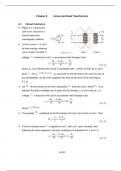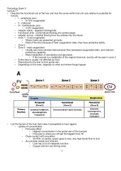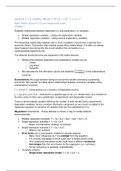14-11-2017
World population: 7,5 + billion
Population
>the aggregate of people:
- Size
- Structures of age and sex
- Geographical distribution
- Its skills and knowledge base
>major components of population change:
- Natural growth/decline:
- Fertility
- Mortality
- Migration (internal, international)
Development
> ‘human development is about people. It is about expanding people’s real choices and the
substantive freedoms - the capabilities - that enable them to lead lives that they value. Choice
and freedom in human development mean something more than the absence of constraints.
People whose lives are blighted by poverty, ill-health or olliteracy are not in any meaningful
sense free to lead the lives that they value. Neither are people who are denied the civil and
political rights they need to influence decisions that affect their lives.’ (UNDP, 2007)
>per capita GNP (the World Bank) vs human development index (UNDP)
>economic, social and cultural change
Sen’s capability approach
>moving away from traditional views on development
>look at inequalities of freedom and choice.
- But: what is real freedom? What is real choice?
- And: are freedom and choice Western or universal values?
How do population and development interlink?
>population only one of a range of possible variables that affect and are affected by
development
>population → development: Malthus (Pop growth= threat to development),
Boserup (pop growth: challenge for development but it is possible), Simon (..)
>development → population: Demographic Transition Model (fertility and mortality
rates)
Stereotypes
>stereotypes frequently use in fundraising campaigns
>’we need to create engagement built on knowledge ,not stereotypes. Why?’
- radi-aid
>give voice to people
,Fundraising campaigns
>Rusty Radiator Awards:
- “The Rusty Radiator Award goes to the fundraising video with the worst use of
stereotypes. This kind of portrayal is not only unfair to the persons portrayed in the
campaign, but also hinders long-term development and the fight against poverty”
>Golden Radiator Awards:
- “The golden radiator award goes to the fundraising video using creativity and creating
engagement. This kind of charity campaign is stepping outside of the common way with
using stereotypes.”
16-11-2017 - population policies and human rights
Population Policies and Planning
>in which respects and to what extent can there be population planning to achieve desired
objectives of population, size, growth, distribution, structure of population quality?
>national targets and priorities, and underlying assumptions:
- Population structures (including ageing)
- Levels of growth
- Fertility
- Mortality, including HIV and AIDS and abortion
- Internal and international migration
- Human resource development: education, knowledge and health
>stimulus to formulate population policies: UN population
>Malthusian assumptions:
- Reduce population growth via family planning policies
- Can reduce short-term expenditure on schooling and health care
>population policies:
- State-driven
- Or via NGOs
- Market-driven
, - Via school system or taxation system
- Culture-driven
- Pronatalist societies; after independence
- Political reasoning
- Lifestyle choices, assured survival of infants
- Son preference: astrology
> Policies in education
- Direct effect: Increase quality of the human resource
- Indirect effect: Lower fertility due to higher education
women
› Age at marriage
- Formal legislation minimum age at marriage
› Contraception
- Most important proximate determinant of fertility
worldwide.
Population and development
>linking population and development
- Millennium Development Goals
- 2000-2015
- Gender inequality
Macro vs micro perspectives
> Macro perspective
- Malthus: population growth and food production
- Rationale for population policies
- ‘bringing about quantitative changes in the membership of the territorially
circumscribed population under the government’s jurisdiction’ (Demeny, 2003)
- Justification: Individual fertility can impose burdens on other members of the
society
>Traditional perspective
- Population planning = family planning and fertility reduction
- How are targets to be achieved?
- Top-down, e.g. one-child policy China
- Or bottom-up?
International population conferences
>1954: Rome (experts demographers)
>1965: Belgrade (experts demographers)
>1974: Bucharest (governmental officials +political leaders +NGOs)
>1984: Mexico city (governmental officials +political leaders +NGOs)
>1994: Cairo (governmental officials +political leaders +NGOs)
› Have evolved through overlapping stages
› Rome en Belgrade: the participants were invited on the basis of their expertise
› 1974: the UN initiated the shift from expert meeting towards intergovernmental gatherings
World population: 7,5 + billion
Population
>the aggregate of people:
- Size
- Structures of age and sex
- Geographical distribution
- Its skills and knowledge base
>major components of population change:
- Natural growth/decline:
- Fertility
- Mortality
- Migration (internal, international)
Development
> ‘human development is about people. It is about expanding people’s real choices and the
substantive freedoms - the capabilities - that enable them to lead lives that they value. Choice
and freedom in human development mean something more than the absence of constraints.
People whose lives are blighted by poverty, ill-health or olliteracy are not in any meaningful
sense free to lead the lives that they value. Neither are people who are denied the civil and
political rights they need to influence decisions that affect their lives.’ (UNDP, 2007)
>per capita GNP (the World Bank) vs human development index (UNDP)
>economic, social and cultural change
Sen’s capability approach
>moving away from traditional views on development
>look at inequalities of freedom and choice.
- But: what is real freedom? What is real choice?
- And: are freedom and choice Western or universal values?
How do population and development interlink?
>population only one of a range of possible variables that affect and are affected by
development
>population → development: Malthus (Pop growth= threat to development),
Boserup (pop growth: challenge for development but it is possible), Simon (..)
>development → population: Demographic Transition Model (fertility and mortality
rates)
Stereotypes
>stereotypes frequently use in fundraising campaigns
>’we need to create engagement built on knowledge ,not stereotypes. Why?’
- radi-aid
>give voice to people
,Fundraising campaigns
>Rusty Radiator Awards:
- “The Rusty Radiator Award goes to the fundraising video with the worst use of
stereotypes. This kind of portrayal is not only unfair to the persons portrayed in the
campaign, but also hinders long-term development and the fight against poverty”
>Golden Radiator Awards:
- “The golden radiator award goes to the fundraising video using creativity and creating
engagement. This kind of charity campaign is stepping outside of the common way with
using stereotypes.”
16-11-2017 - population policies and human rights
Population Policies and Planning
>in which respects and to what extent can there be population planning to achieve desired
objectives of population, size, growth, distribution, structure of population quality?
>national targets and priorities, and underlying assumptions:
- Population structures (including ageing)
- Levels of growth
- Fertility
- Mortality, including HIV and AIDS and abortion
- Internal and international migration
- Human resource development: education, knowledge and health
>stimulus to formulate population policies: UN population
>Malthusian assumptions:
- Reduce population growth via family planning policies
- Can reduce short-term expenditure on schooling and health care
>population policies:
- State-driven
- Or via NGOs
- Market-driven
, - Via school system or taxation system
- Culture-driven
- Pronatalist societies; after independence
- Political reasoning
- Lifestyle choices, assured survival of infants
- Son preference: astrology
> Policies in education
- Direct effect: Increase quality of the human resource
- Indirect effect: Lower fertility due to higher education
women
› Age at marriage
- Formal legislation minimum age at marriage
› Contraception
- Most important proximate determinant of fertility
worldwide.
Population and development
>linking population and development
- Millennium Development Goals
- 2000-2015
- Gender inequality
Macro vs micro perspectives
> Macro perspective
- Malthus: population growth and food production
- Rationale for population policies
- ‘bringing about quantitative changes in the membership of the territorially
circumscribed population under the government’s jurisdiction’ (Demeny, 2003)
- Justification: Individual fertility can impose burdens on other members of the
society
>Traditional perspective
- Population planning = family planning and fertility reduction
- How are targets to be achieved?
- Top-down, e.g. one-child policy China
- Or bottom-up?
International population conferences
>1954: Rome (experts demographers)
>1965: Belgrade (experts demographers)
>1974: Bucharest (governmental officials +political leaders +NGOs)
>1984: Mexico city (governmental officials +political leaders +NGOs)
>1994: Cairo (governmental officials +political leaders +NGOs)
› Have evolved through overlapping stages
› Rome en Belgrade: the participants were invited on the basis of their expertise
› 1974: the UN initiated the shift from expert meeting towards intergovernmental gatherings










